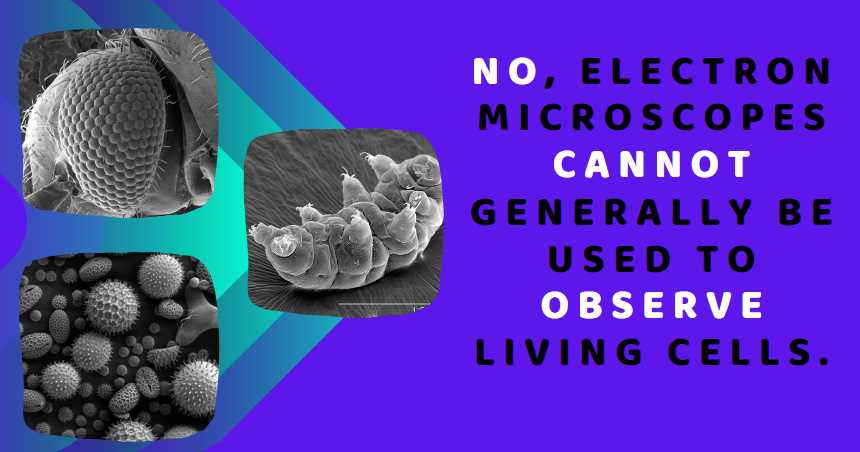No, electron microscopes cannot generally be used to observe living cells.
The preparation process for electron microscopy involves dehydration and vacuum conditions that are incompatible with maintaining living cells.
| Image | Product | Detail | Price |
|---|---|---|---|
 | Carson MicroBrite Plus 60x-120x LED Lighted Pocket Microscope |
| See on Amazon |
 | Elikliv LCD Digital Coin Microscope |
| See on Amazon |
 | AmScope M150 Series Portable Compound Microscope |
| See on Amazon |
 | PalliPartners Compound Microscope for Adults & Kids |
| See on Amazon |
 | Skybasic 50X-1000X Magnification WiFi Portable Handheld Microscopes |
| See on Amazon |

Electron microscopes use electron beams instead of light to achieve much higher resolution images than light microscopes. However, the sample preparation for electron microscopy involves fixing, dehydrating, and embedding the specimen in a resin. This process is unsuitable for preserving living cells’ delicate structures and functions. Dehydration and exposure to a vacuum can cause cellular structures to collapse and lose their natural state.
Other techniques, such as light or confocal microscopy, are typically used to visualize living cells. These methods allow real-time observation of dynamic cellular processes without extensive sample preparation.
| Characteristic | Transmission Electron Microscope (TEM) | Scanning Electron Microscope (SEM) |
|---|---|---|
| Resolution | 0.1 nanometers or better | 1-10 nanometers |
| Magnification | Up to 50 million times | Up to 2 million times |
| Sample Preparation | Thin sectioning and staining | Coating with a thin layer of metal |
| 3D Imaging Capability | Limited | Yes |
| Depth of Field | Narrow | Broad |
| Types of Specimens | Thin sections of biological samples | Solid surfaces |
| Image Type | 2D cross-sectional images | 3D surface images |
| Applications | Subcellular structures, viruses, etc. | Surface morphology, material science |
| Vacuum Requirement | High vacuum | High vacuum |
| Cost | Expensive | Expensive |
Basics of Electron Microscopy
In microscopic exploration, electron microscopy stands as a paramount tool, revealing the hidden intricacies of the nanoscale world. This section will delve into the fundamental principles of electron microscopy, outlining the two primary types—Transmission Electron Microscopes (TEM) and Scanning Electron Microscopes (SEM).
Types of Electron Microscopes
Electron microscopes, owing to their exceptional resolution, are categorized into two main types: Transmission Electron Microscopes (TEM) and Scanning Electron Microscopes (SEM).
Transmission Electron Microscope (TEM)
TEM operates on the principle of transmission, where a beam of electrons passes through an ultrathin specimen. The interaction of electrons with the specimen provides detailed insights into its internal structures. This type of electron microscope has been instrumental in unraveling the ultrastructure of cells, showcasing cellular components with remarkable detail.
Scanning Electron Microscope (SEM)
On the other hand, SEM employs a different approach. Instead of transmitting electrons through the specimen, SEM scans its surface. This scanning process generates a 3D image, revealing the topography of the specimen. SEM is particularly useful for studying the surface features of cells and other microscopic structures.
Sample Preparation in Electron Microscopy
A critical aspect of electron microscopy is the preparation of biological samples, which significantly influences the quality of the obtained images.
Fixation and Staining Techniques
Researchers employ fixation and staining techniques to enhance contrast and reveal specific cellular structures. Chemical fixatives, such as formaldehyde, stabilize cellular structures, preventing degradation during the imaging process. Additionally, heavy metal stains, like osmium tetroxide, interact with specific cellular components, further enhancing contrast.
Types of Electron Microscopes
| Microscope Type | Operating Principle | Main Application |
|---|---|---|
| TEM | Transmission of Electrons through Specimen | Internal Structure of Cells |
| SEM | Scanning Surface with Electrons | Surface Topography of Cells |
Fixation and Staining Techniques
| Technique | Purpose | Examples |
|---|---|---|
| Chemical Fixation | Stabilize Cellular Structures | Formaldehyde |
| Heavy Metal Stains | Enhance Contrast | Osmium Tetroxide |
Advances in Live Cell Imaging with Electron Microscopy
Cryo-Electron Microscopy (Cryo-EM)
Innovative techniques have propelled advancements in live cell imaging, and one notable breakthrough is cryo-electron microscopy (Cryo-EM). This method addresses the challenges faced by traditional electron microscopy when observing living cells.
Preservation of Cell Structures at Low Temperatures
Cryo-EM involves rapidly freezing biological samples, preserving them at ultra-low temperatures. This process, known as vitrification, retains cellular structures in a near-native state. By avoiding the distortions caused by conventional sample preparation methods, Cryo-EM provides a unique opportunity to capture dynamic cellular processes without compromising structural integrity.
Cryo-Electron Microscopy (Cryo-EM)
| Advancement | Description |
|---|---|
| Preservation of Cell Structures | Rapid freezing preserves cellular structures at low temps. |
| Near-Native State Imaging | Retains cellular integrity for studying dynamic processes. |
Cryo-EM Applications in Studying Living Cells
Cryo-EM has found diverse applications in the realm of live cell imaging. From unraveling the intricacies of cell division to examining viral infection mechanisms, this technique offers a new dimension in understanding the dynamic nature of living cells.
Applications of Cryo-Electron Microscopy
| Cellular Process | Cryo-EM Application |
|---|---|
| Cell Division | Study of dynamic events during cell division. |
| Viral Infection | Unraveling mechanisms of viral entry and replication. |
Correlative Light and Electron Microscopy (CLEM)
Another significant stride in live cell imaging is the integration of correlative light and electron microscopy (CLEM). This approach seamlessly merges the strengths of light microscopy with the high resolution of electron microscopy.
Integration of Light and Electron Microscopy
CLEM begins with live-cell imaging using light microscopy, capturing dynamic events in real time. Once specific structures of interest are identified, the specimen transitions to an electron microscope for high-resolution imaging. This integration allows researchers to correlate real-time observations with detailed structural information.
Correlative Light and Electron Microscopy (CLEM)
| Integration Process | Benefits |
|---|---|
| Light Microscopy Observation | Real-time capture of dynamic cellular events. |
| Transition to Electron Microscopy | High-resolution imaging for detailed structural information. |
Real-time Imaging of Living Cells
The real strength of CLEM lies in its ability to provide a comprehensive understanding of living cells. By bridging the gap between dynamic processes observed through light microscopy and detailed structural analysis via electron microscopy, CLEM has become an invaluable tool in the study of cellular dynamics.
Real-time Imaging in Correlative Light and Electron Microscopy
| Observation Technique | Strengths |
|---|---|
| Light Microscopy | Real-time observation of dynamic cellular processes. |
| Electron Microscopy | High-resolution imaging for detailed structural analysis. |
Limitations and Future Prospects
While the recent advancements in live cell electron microscopy have been groundbreaking, certain limitations still hinder its widespread application.
Technical Constraints
One primary challenge is the existence of technical constraints. The resolution achieved in live cell electron microscopy is often lower compared to static samples. This limitation poses challenges in capturing the intricate details of dynamic cellular processes.
Resolution Challenges
The quest for higher resolution remains an ongoing pursuit. Achieving atomic-level resolution in live cell imaging proves to be particularly challenging due to the dynamic nature of biological samples and the potential damage caused by electron beams.
Table 1: Current Limitations of Live Cell Electron Microscopy
| Challenges | Description |
|---|---|
| Technical Constraints | Limitations in resolution for dynamic cellular processes. |
| Resolution Challenges | Difficulty in achieving atomic-level resolution in vivo. |
Emerging Technologies and Future Directions
Despite the current limitations, the field of live cell electron microscopy is dynamic, with ongoing research and emerging technologies pointing towards a promising future.
Advancements in Microscopy Techniques
Researchers are actively exploring advancements in microscopy techniques, aiming to overcome current limitations. Adaptive optics and novel sample preparation methods are being investigated to enhance resolution and minimize potential damage to living cells.
Potential Breakthroughs in Live Cell Imaging
The future holds exciting prospects for live cell imaging. Continued innovation may lead to breakthroughs that enable researchers to explore cellular dynamics with unprecedented clarity. The integration of artificial intelligence (AI) for real-time analysis and improved environmental control chambers are among the potential avenues that could shape the future of live cell electron microscopy.
Future Directions in Live Cell Electron Microscopy
| Technological Advances | Potential Impact |
|---|---|
| Adaptive Optics | Enhanced resolution for dynamic cellular processes. |
| AI Integration | Real-time analysis for improved understanding of dynamics. |
| Advanced Environmental Control | Minimizing environmental impact on living cell integrity. |
Conclusion
Electron microscopes have revolutionized our understanding of living cells by allowing us to observe their intricate structures and processes. These powerful instruments have pushed the boundaries of scientific exploration, enabling researchers to delve deeper into the world of microscopic organisms.
Through their high-resolution imaging capabilities, electron microscopes have provided invaluable insights into the behavior and characteristics of living cells. With continued advancements in technology, we can expect even greater discoveries and advancements in our knowledge of these fascinating building blocks of life.

Fahim Foysal is a well-known expert in the field of binoculars, with a passion for exploring the great outdoors and observing nature up close. With years of experience in the field, Fahim has honed his skills as a binocular user and has become a go-to resource for those seeking advice on choosing the right binoculars for their needs.
Fahim’s love for the natural world began during his time at The Millennium Stars School and College and BIAM Laboratory School, where he spent much of his free time exploring the outdoors and observing the wildlife around him. This passion for nature led him to pursue a degree in Fine Arts from the University of Dhaka, where he gained a deep understanding of the importance of observation and attention to detail.
Throughout his career, Fahim has used his expertise in binoculars to help others discover the beauty of the natural world. His extensive knowledge of binocular technology and optics has made him a trusted advisor for amateur and professional wildlife observers alike. Whether you’re looking to spot rare birds or observe animals in their natural habitats, Fahim can help you choose the perfect binoculars for your needs. With his guidance, you’ll be able to explore the outdoors with a newfound appreciation for the beauty of the natural world.
Table of Contents
